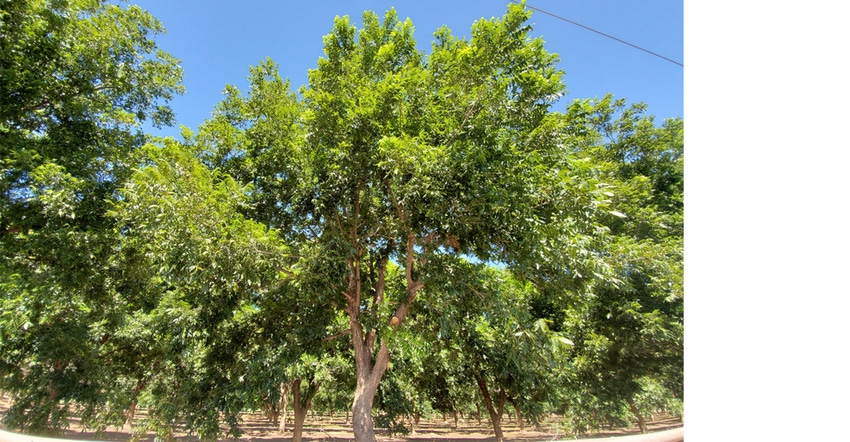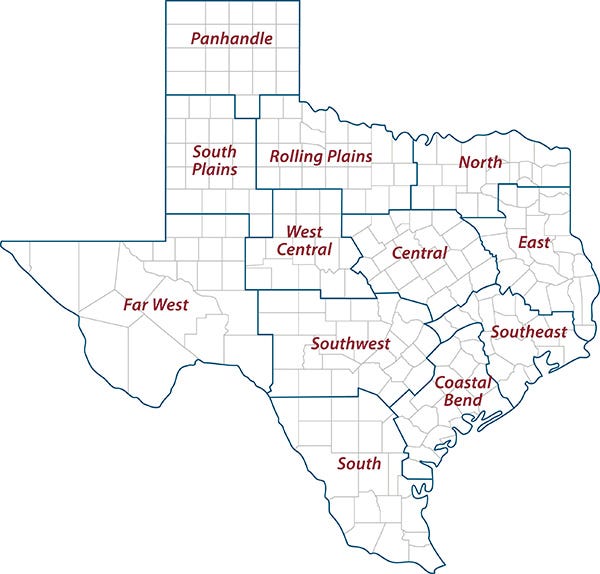
Texas pecan growers could expect another subpar year despite good moisture early in the 2019 season, according to a Texas A&M AgriLife Extension Service expert.
Dr. Larry Stein, AgriLife Extension fruit specialist, Uvalde, said yield estimates for Texas were low this season, 30 million to 36 million pounds. Texas pecan trees typically produce around 50 million pounds in a good year.
“This year is hit and miss for much of the pecan-producing areas, especially West Texas,” he said. “Producers there had a big crop in 2018, and it’s typical to see yields drop off after a big harvest. But it looks like they really dropped off around the state. South Texas looks to be having a good year, but again, it’s been hit and miss this season overall.”
The U.S. Department of Agriculture June summary report put Texas pecan production for 2018 at 33.6 million pounds from 112,000 acres compared to 48.99 million pounds from 115,000 acres in 2017.
Conditions in June were favorable with good moisture levels, but over the last six weeks conditions have turned arid, Stein said. Nut sizes are larger due to good spring conditions, which means it will take plenty of fertilizer and water for proper kernel fill.
“The big challenge at this point is that it takes water and nitrogen to fill the kernels, and most areas of the state have been missing rain for the last two months,” he said. “Irrigation will be key if we don’t start seeing some timely rains.”
Stein makes the following recommendations:
trees should receive 2 inches of water weekly up to shuck split
irrigated water should be applied around the tree’s dripline
trees’ water input should be supplemented with irrigation through mid-September — or the first good fall rain — to ensure they are not stressed going into winter
trees need 10 to 20 pounds of ammonium sulfate or urea per acre in August and September on heavily loaded trees
“If trees can’t get enough nitrogen from the soil, they’ll take it from the leaves,” he said. “So, you’ll notice leaves turning yellow and dropping off.”
Pests can also reduce nut quality, Stein said.
Insects, including hickory shuckworm, black aphids, weevils and stinkbugs, are a top concern for pecan production at this point in the season, he said. Shuckworms, weevils and stinkbugs directly affect the nut, while aphids can cause leaf damage, which can stress the tree.
“The threshold for black aphids is very low, so they need to be controlled aggressively,” he said. “Usually shuckworm sprays will take care of pecan nut casebearer and some of the other pests that impact yields. So, targeting one will take care of others.”
Stein said homeowners may notice dripping excretions if they park under pecan trees. The sappy excretion is from yellow aphids, which feed on leaves and expel the liquid. Typically, yellow aphids won’t harm trees, and populations typically crash without treatment.
Despite challenges, Stein said producers who actively thinned trees, monitored for and treated pests and followed prescribed irrigation recommendations should see decent to good yields and quality.
“The good news is that we’ve had good deep soil moisture,” he said. “We couldn’t say that just a few years ago. It’s just now getting dry, so we just need to feed and water the trees, and watch for bugs that want our pecans.”
AgriLife Extension district reporters compiled the following summaries:

The 12 Texas A&M AgriLife Extension Districts
CENTRAL: Nearly all counties reported short soil moisture levels. Dry and hot conditions reduced pasture quality for cattle. Some producers began to feed round bales. Hot, dry conditions were good for corn and sorghum harvests, which were in full swing. Producers were cutting and baling hay, but grass production was slowed by weather conditions. Some brush work was done. Livestock were in good condition. Cotton producers were irrigating at maximum capacity. Stock tank levels were dropping.
ROLLING PLAINS: Conditions were hot, windy and dry. Cotton fields were in good condition but needed moisture. Pastures were drying up fast, and hay making slowed due to lack of rain. Fire potential was becoming a concern.
COASTAL BEND: Conditions were hot and humid, with no rain during the reporting period or in the forecast. Burn bans were imposed in a few counties due to dry conditions. The dry weather was favorable for crop harvests. Most grain sorghum and corn were harvested. Cotton was being defoliated in some areas, and harvest was in full swing in other areas with most growers seeing slightly above-average yields. Rice was being harvested and soybeans were drying down. Post-harvest fieldwork was being done. Pastures and hayfields were drying fast. Livestock grazing was running short in some pastures. Some cattle producers began supplemental feeding. Some cattle were being marketed to reduce stocking rates.
EAST: Drier conditions continued over most of the district. Many areas needed rainfall. Pastures started to turn brown. Hay production continued with most producers finishing their second cutting. Sabine County producers were able to get harvesting equipment into bottomlands for the first time in months. Temperatures increased to triple digits. Pasture and rangeland conditions were fair to good. Subsoil and topsoil conditions were adequate to short. Anderson County reported that peas, okra, melons and tomatoes were still looking pretty good. Livestock were in good condition. Wild pigs caused damage. Bermuda grass stem maggot infestations increased, and there were reports of armyworms. Horn flies were a problem in Anderson County.
SOUTH PLAINS: Subsoil and topsoil moisture levels were drying out due to lack of rainfall and daytime temperatures beyond 100 degrees. All counties needed some rain. Some producers were monitoring irrigation. Cotton fields looked great with good heat units. Producers were monitoring for pests in all crops. Rangeland and pastures were in fair to good condition. Cattle were in good condition.
PANHANDLE: Temperatures reached triple digits across the district with low humidity. Subsoil and topsoil were short. The heat stressed crops, rangeland and livestock. Corn was in fair condition. Cotton growth stages in the southwestern Panhandle remained behind. Irrigation continued in corn, cotton, sorghum and soybeans across the district. Rangelands were in fair condition. Livestock conditions declined as temperatures increased.
NORTH: A few counties reported adequate soil moisture, but the majority reported short to very short soil moisture levels. Rain was needed badly across the district. Soils were beginning to crack from the 90 to 100 degree temperatures. Corn was doing well and being harvested. Cotton and soybeans looked decent, but projected yields were expected to be down. Hay was harvested. Pastures and hayfields had a little green in most of them, but they needed moisture. Sorghum was mature, so harvesting for most farmers should begin soon. Some farmers reported sighting sugarcane aphids in sorghum and johnsongrass. Livestock were in good condition. Grasshopper numbers increased, and Bermuda grass stem maggots were spotted.
FAR WEST: Average temperatures reached beyond 100 degrees with lows in the 70s. Trace amounts of scattered precipitation were reported. Conditions were decreasing soil moisture levels and drying out rangeland and pastures. The wet spring and early summer produced lots of grass, brush and field crops, which created lots of fuel for grass fires. A few fires were reported and contained, but approximately 7,000 acres were burned. Cotton crops were holding on, but some started to shed squares and bolls. Pecan weevil traps were set to monitor pest movements in orchards. Hay producers cleared fields of their last hay cutting without significant rain. Pest numbers were fairly light, but producers were seeing some stink bugs, aphids and spider mites in areas. Grazing livestock were hit hard by the heat, and producers were providing supplemental hay and feed to livestock and wildlife.
WEST CENTRAL: Temperatures reached beyond 100 degrees and continued to deplete soil moisture levels. Grasses continued to dry out with most going into summer dormancy. Stock tank levels were in pretty decent shape for August but were beginning to decline. Sorghum harvest continued and yields were good. Grasshoppers were prevalent in pastures and continued to defoliate mesquite trees. Livestock were in fair to good condition, but heat stress was becoming a factor. Cattle markets were steady to a couple of dollars higher. Yearling steers were $2-$3 higher per hundredweight, and heifers were steady to $2 per hundredweight higher.
SOUTHEAST: Conditions were hot and dry. Corn harvest began. Pastures and crops needed water. Fire concerns increased because of the amount of dry fuel present. Rangeland and pasture ratings varied from excellent to poor with fair ratings most common. Soil moisture levels ranged from adequate to very short with adequate being most common.
SOUTHWEST: Moisture conditions continued to decrease as temperatures increased. No rain was received or in the forecast. Rangeland and pasture conditions declined, and grasses were turning brown. Dry river beds and grass fires were reported. Sutton County confirmed nine anthrax cases. Livestock conditions were decent considering the drought.
SOUTH: Hot and dry weather conditions with very short to short soil moisture levels were reported. Several counties reported temperatures beyond 100 degrees. Dimmit County reported trace amounts of scattered rain, but most parts of the district missed moisture. Corn harvest in Atascosa County was complete and ongoing in other counties. Cotton and peanuts were being irrigated. Cotton was in boll stage and nearing harvest rapidly in some areas. Some cotton fields in Zavala County reached boll weevil thresholds and required pesticide applications. In Kleberg and Kennedy counties, cotton harvest was midway, and preliminary yields were 2.5 to 3 bales per acre. Peanuts were in the pegging stage. Rangeland and pasture conditions continued to decline due to lack of rain. Fall calving season began for some producers with many others to begin soon. Livestock producers increased supplemental feeding, and some were hauling water. Livestock body conditions were starting to slip due to poor grazing conditions and hot temperatures. Irrigated forage was doing well. Irrigated vegetable crop fields were in good condition. Watermelon and cantaloupe crops were almost finished. Coastal Bermuda grass fields were producing good hay bales. Zavala County reported active corn and sorghum harvesting. Pecan growers continued water applications.
About the Author(s)
You May Also Like




